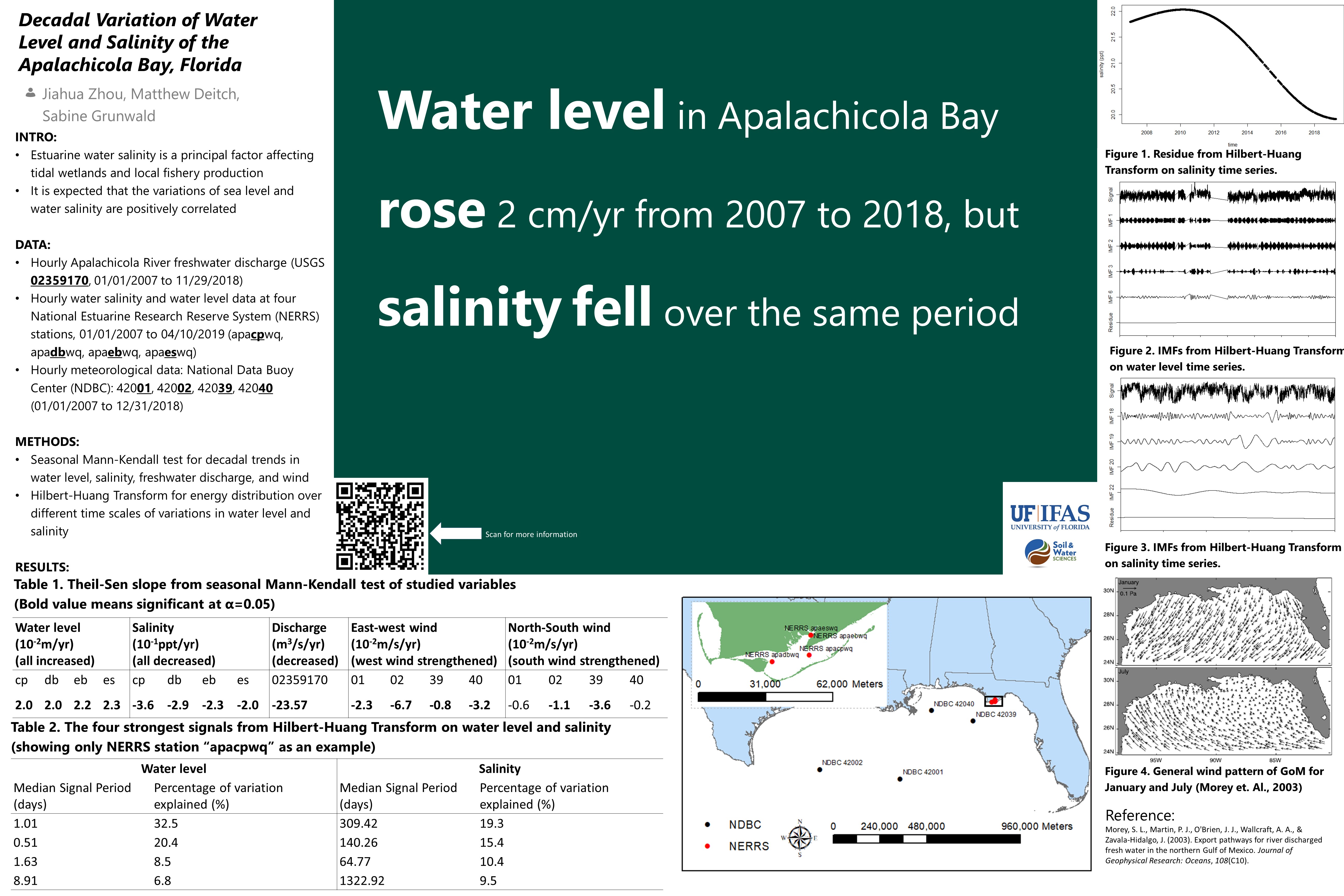
Abstract
Estuarine water salinity is a principal factor affecting coastal wetlands and local fishery production. We used a seasonal Mann-Kendall test and a Hilbert-Huang transform to analyze the trend of water level and salinity from 2007 to 2018 for the Apalachicola Bay in Florida. The seasonal Mann-Kendall test was also conducted on Apalachicola River discharge and Gulf of Mexico (GoM) wind speed to raise explanations for the phenomenal we observed. Our results showed that over the analyzed period, the water level of the bay has increased at an average rate of 2-2.3 cm/yr. However, the water salinity has decreased at an average rate of 0.2-0.36 ppt/yr. Meanwhile, the freshwater discharge from the river significantly decreased at an average rate of 23.57 m3/s/yr. GoM west wind and south wind speed has increased. According to the decadal trends of the mentioned factors, we hypothesize that freshwater has drifted from the northwest GoM estuaries and caused water salinity of the Apalachicola Bay to decrease even as water level increased.
Data
- Hourly Apalachicola River freshwater discharge (USGS 02359170, 01/01/2007 to 11/29/2018)
- Hourly water salinity and water level data at four National Estuarine Research Reserve System (NERRS) stations, 01/01/2007 to 04/10/2019 (apacpwq, apadbwq, apaebwq, apaeswq)
- Hourly meteorological data: National Data Buoy Center (NDBC): 42001, 42002, 42039, 42040 (01/01/2007 to 12/31/2018)
Methods
Seasonal Mann-Kendall test:
The Seasonal Mann-Kendall test is a nonparametric method that tests for monotonic trends of a time series, when the data is collected over “seasons” (can be spring/summer, wet/dry seasons, Jan/Feb etc.). While a traditional Mann-Kendall test tau is calculated based on the connections between each pair of data points in the time series, seasonal Mann-Kendall tau only accounts for connections within the same season. In this way, the seasonal pattern will not affect the test result.
In our study, data points were grouped into 12 seasons based on the month the samples were taken. The interannual circles of the tested time series were therefore not relevant to the tested trends.
Hilbert-Huang Transform:
Hilbert-Huang Transform is a way to decompose a nonstationary and nonlinear time series into signals that have different frequencies. This is done through empirical mode decomposition (EMD). The EMD process is as follows:
- For the original time series X0, identify its local maxima (X0max) and minima (X0min); use a cubic spline to connect data points of X0max(X0min) to form the upper(lower) limit function X0up(X0low). Let X0mean=1/2(X0up+X0low).
- Let X01=X0-X0mean.
- Repeat the previous two steps on the new time series X01 and so on, until the outcome X0i becomes an intrinsic mode function (IMF), which is a function that: 1) has the same number of local maxima, local minima and zero crossings, or 2) its number of local maxima, local minima and zero crossings are different by 1. These steps are called sifting. Let IMF1=X0i.
- Let X1=X0-IMF1. Repeat the previous three steps on X1 to obtain IMF2, and so on, until Xi becomes a constant, a monotonic function, or a function that has only one local maxima and local minima. This Xi is then called residue.
Obviously, X0 is equal to the sum of all IMFs and the residue. Each IMF reflects the oscillation of the decomposed variable of a certain time scale (or frequency) and has a corresponding physic process. The residue is the long-term trend of this variable over the observed time span, corresponding to a process that has a period longer than the time span of the data record.
Discussion
Sea level and freshwater discharge are often major factors of estuarine water salinity models (Morey & Dukhovskoy, 2012; Perales-Valdivia, Sanay-González, & Valle-Levinson, 2018; Ross et al., 2015). It is often assumed that salinity will increase when sea level increases and fall when freshwater discharge increases. However, in our case study, the water salinity of Apalachicola Bay has decreased significantly when sea level has increased and freshwater discharge decreases, from 2007 to 2018. This phenomenon implies that there may be other process that controls the water salinity of this region.
The seasonal Man-Kendall tests on the surface wind over northern GoM revealed that there is an increase of south wind speed and west wind speed over the analyzed period. Morey (2003) pointed out that the seasonal wind pattern is responsible to the seasonal variation of offshore water salinity of the northern GoM. Freshwater drifts eastward from the Mississippi estuary during summer and fall under southwest wind and westward under northeast wind during winter and spring. Based on their findings, the strengthened south wind speed and west wind speed may explain the salinity decrease of the Apalachicola Bay.
Conclusion
Our finding suggests that the exchange of estuarine water and offshore ocean water can be very important in understanding decadal salinity variations. Local landscape variables (sea level and river discharge) may not be sufficient to predict estuarine water salinity in this time scale.
References
Morey, S. L., & Dukhovskoy, D. S. (2012). Analysis Methods for Characterizing Salinity Variability from Multivariate Time Series Applied to the Apalachicola Bay Estuary. Journal of Atmospheric and Oceanic Technology, 29(4), 613–628. https://doi.org/10.1175/JTECH-D-11-00136.1
Morey, S. L., Martin, P. J., O’Brien, J. J., Wallcraft, A. A., & Zavala‐Hidalgo, J. (2003). Export pathways for river discharged fresh water in the northern Gulf of Mexico. Journal of Geophysical Research: Oceans, 108(C10). https://doi.org/10.1029/2002JC001674
Perales-Valdivia, H., Sanay-González, R., & Valle-Levinson, A. (2018). Effects of tides, wind and river discharge on the salt intrusion in a microtidal tropical estuary. Regional Studies in Marine Science, 24, 400–410. https://doi.org/10.1016/j.rsma.2018.10.001
Ross, A. C., Najjar, R. G., Li, M., Mann, M. E., Ford, S. E., & Katz, B. (2015). Sea-level rise and other influences on decadal-scale salinity variability in a coastal plain estuary. Estuarine, Coastal and Shelf Science, 157, 79–92. https://doi.org/10.1016/j.ecss.2015.01.022



